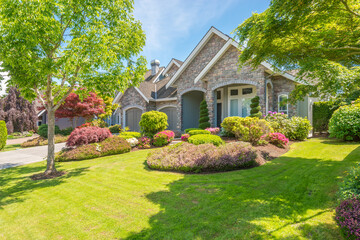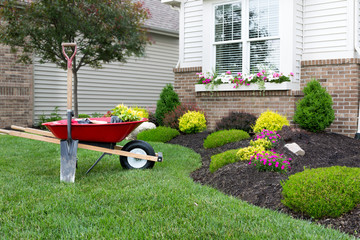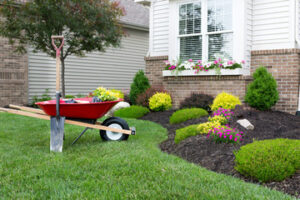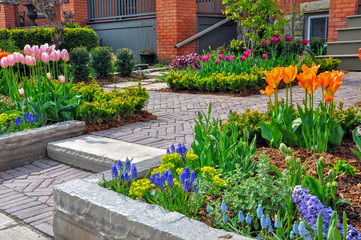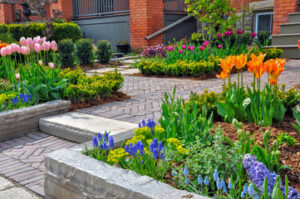A well-planned landscape can add to your home’s value without the expense of a complete remodel or extra square footage. Landscaped yards also encourage people to spend more time outdoors, which improves mental health.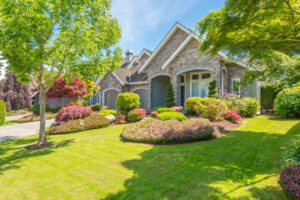
Texture is an important landscape element that provides depth and interest. Grass, flowers, trees and paths all have different textures. Contact Landscaping Stafford VA for professional help.
One of the primary functions of landscaping is to boost a home’s aesthetic appeal. This includes pruning bushes and trees, trimming hedges, and edging gardens to create a clean and crisp look. It also involves selecting beautiful plants and flowers that will complement the home’s architecture. This aesthetic touch is important for attracting potential buyers and increasing the value of a property. In addition, studies show that resting in a beautifully landscaped garden can benefit a person both mentally and physically.
While the word “aesthetic” is often associated with art, it also applies to the way people respond to the natural environment. Landscape aesthetics is the study of the visual appeal of outdoor spaces and how they affect people’s emotions and sense of place. It combines concepts from both environmental psychology and the field of landscape architecture to create aesthetically pleasing and emotionally engaging outdoor spaces.
The term landscape refers to the entire built environments of mankind as well as the natural or semi-natural terrestrial environments on Earth, including urban areas, public and private gardens, parks and theme parks, agricultural land, forests, plains, and biomes such as the savannah or rainforest. Aesthetic consideration of landscape is therefore a vast and diverse subject. The study of landscape aesthetics has involved both desk and field research. In desk research, areas that have high landscape values are identified through landscape metrics and landscape analysis. These are then assessed and compared with those that have low landscape values, in order to establish the relative value of a given area.
Field route studies are another method used in landscape aesthetics, and they involve identifying and evaluating specific landscape features along a specified path. These evaluations can be carried out by individuals or by groups of people. One of the most popular methods of landscape aesthetic research is the use of photo-elicitation questionnaires, which are designed to elicit specific emotional responses from individuals.
Landscape design is an artful endeavor, and establishing balance between aesthetics and function can be challenging. A good way to achieve this is by integrating unique elements, such as water features or artistic sculptures, into your landscape. These focal points will draw the eye and evoke emotion, resulting in a more cohesive design that harmonizes with its surroundings. The art of unity is key, as well – incorporating the same plants or materials throughout your landscape creates a seamless design that draws the eye across the space.
Function
One of the primary purposes of landscaping is to create functional outdoor spaces. This includes designing and constructing elements like gardens, walkways, patios, and retaining walls that add aesthetic appeal to the property while also providing practical functions such as privacy, shelter from wind and sun exposure, and water management.
Landscaping also involves the selection and arrangement of plants. The landscaper chooses species that thrive in the region and can adapt to its climate, soil conditions, and water requirements. They may also incorporate sustainable features like rain gardens to reduce environmental impact.
As a new landscaping company, it’s important to establish a strong brand identity that sets you apart from the competition and makes your business more recognizable. Developing a logo and website will help you build brand awareness, while also helping potential customers find your services online. In addition, it’s crucial to keep track of your finances and pricing strategies as you start growing your business. By using accounting software, you can stay on top of your expenses and make sure you’re pricing your services to cover overhead and earn a profit on each job.
In addition to enhancing the appearance of a home, landscaping can also increase its value. It can also improve the health of the environment by reducing air pollution, minimizing noise pollution, and adding visual interest to an urban or suburban setting. In fact, studies have shown that homes with well-maintained landscaping are more likely to sell or rent faster than those without them.
If you’re looking to add curb appeal to your home or business, hiring a professional landscaper is the best way to go. These professionals have the expertise and tools to create a beautiful garden that will last for years. Plus, they can help you save money in the long run by saving on maintenance and water bills. In addition, they can provide you with valuable advice that will ensure your garden stays healthy and aesthetically pleasing for as long as possible.
Maintenance
Landscapers design and maintain outdoor spaces that balance aesthetics and functionality. The primary objectives of landscaping are to improve a property’s visual appeal and add value to the home. In addition, landscaping is an ecofriendly practice that provides wildlife with food, shelter, and other resources.
Unlike gardening, which is primarily focused on growing flowers and vegetables, landscaping involves both the arrangement of plants as well as the modification of terrain. Landscaping also incorporates structural elements such as patios, walkways, water features, retaining walls, and lighting to increase the usability of outdoor spaces.
The primary tasks of landscape maintenance include lawn mowing, pruning, and weed prevention. Adding mulch to the garden beds and turf areas helps regulate soil temperature, reduce weed growth, and keep the area looking neat. Performing regular soil testing and amendments to ensure that the plants are receiving adequate nutrients is also important.
Another aspect of landscape maintenance is preventing erosion and standing water by installing drainage systems. It is also essential to keep trees healthy by pruning and maintaining their size as well as removing any unhealthy or dead branches.
Seasonal changes also require special attention to the landscaping of a home. For example, the blooming of plants in spring requires frequent pruning, and hot summer temperatures can necessitate increased watering and shade. The climate of a region also influences the type of vegetation that thrives in specific locations and the time of year when pests and diseases are more prevalent.
Landscaping can be a complex process that requires the services of professionals. A professional landscaper will conduct a terrain assessment and develop a design plan to achieve the desired look while remaining within budget. Once the design is finalized, the landscaper will implement the hardscaping and softscaping components of the project. Finally, a maintenance schedule will be created to help the homeowner stay on top of recurring tasks. Keeping up with the landscape maintenance of your home will ensure that it is always in pristine condition and continues to enhance the property’s value. If you are unsure of how to proceed with your landscaping project, contact Newport Ave Landscaping for professional assistance.
Value
Landscaping is not only aesthetic, it’s also a great way to increase your custom home property value and make your outdoor areas more functional. However, it’s important to understand the basics of landscaping before you begin any project. Consider the initial installation costs and ongoing maintenance expenses to determine if your project will be financially beneficial.
When it comes to curb appeal, the value of your home’s landscape is a significant factor in how potential buyers perceive your property. In fact, a well-kept and beautifully landscaped yard can boost your home’s value by up to 20 percent.
To improve your curb appeal, choose a design theme that reflects the style of your home. Incorporate elements that complement the structure of your home, like a water feature, to create a harmonious, balanced appearance. You can also add decorative accents, such as lanterns and statues, to attract more attention and create a more appealing focal point. Lastly, be sure to incorporate color, texture, and variety in your plantings to provide visual interest.
Whether your landscape is large or small, it should be professionally designed and maintained to achieve its full potential. A professional landscaper can help you create a plan that meets your goals and fits your budget. They will also take into consideration the weather and environmental factors that can affect your landscape.
When choosing a landscaping company, look for one that is licensed and insured. In Australia, all landscape professionals must have a Certificate III in Landscape Construction (AHC30916) to be qualified to work in the industry. They should also be registered with the Regulatory Council of Landscapers in your state or territory.
A well-designed and maintained landscape can increase your custom home’s value and improve the quality of your life. A well-maintained yard is an inviting place for friends and family to gather, and it can also be a great source of entertainment for kids and pets.
In a recent survey, real estate agents reported that poor landscaping negatively impacts the saleability of a property. Forty-three percent said it has a “very negative” impact, while 38% say it has a “somewhat negative” impact.

